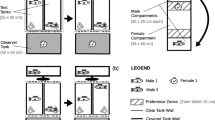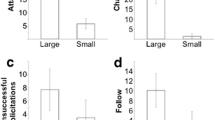Abstract
Male expected reproductive success can be enhanced by increased mating success (mate number) or, when females can mate multiply, by increased mating exclusivity (i.e., reduced partner promiscuity). A positive or negative covariance between these two mating outcomes could substantially increase or decrease overall variation in male expected reproductive success, yet the relationship between these mating outcomes is relatively understudied. We examined this relationship and the influence of male personality traits, female personality traits, and the social environment on mating outcomes in stream water striders, Aquarius remigis, at two experimental sex ratios: equal and 2:1 male-biased. To our knowledge, this study is the first to quantify this full set of effects. We found that mating frequency (mating success) and mating exclusivity were positively correlated in the male-biased treatment, but were not related at equal sex ratios. At both sex ratios, males that were more active and aggressive had both higher mating frequency and higher mating exclusivity. A male’s effective mating (the product of mating frequency and mating exclusivity) was also higher if on average he mated with females that tended to hide in refuges (and were presumably less available for future matings). Finally, males that were more often in pools with extremely aggressive (“hyperaggressive”) males actually had increased mating exclusivity, potentially because hyperaggression reduced average female promiscuity. This study highlights the importance of considering mating outcomes beyond mating success and examining the simultaneous contribution of male behaviours, female behaviours and social factors to mating dynamics.

Similar content being viewed by others
References
Albrecht T, Schnitzer J, Kreisinger J, Exnerová A, Bryja J, Munclinger P (2007) Extrapair paternity and the opportunity for sexual selection in long-distant migratory passerines. Behav Ecol 18(2):477–486. doi:10.1093/beheco/arm001
Andersson MB (1994) Sexual selection. Princeton University Press, Princeton
Arnold SJ (1994) Bateman’s principles and the measurement of sexual selection in plants and animals. Am Nat 144 (ArticleType: research-article / Issue Title: Supplement: Sexual Selection in Plants and Animals / Full publication date: Aug., 1994 / Copyright © 1994 The University of Chicago):S126-S149. doi:10.2307/2462732
Arnold SJ, Wade MJ (1984a) On the measurement of natural and sexual selection: applications. Evolution 38(4):720–734. doi:10.2307/2408384
Arnold SJ, Wade MJ (1984b) On the measurement of natural and sexual selection: theory. Evolution 38(4):709–719. doi:10.2307/2408383
Arnqvist G, Rowe L (2005) Sexual conflict. Monographs in behavior and ecology. Princeton University Press, Princeton
Baayen RH (2011) languageR: data sets and functions with “Analyzing linguistic data: a practical introduction to statistics”. R package version 1.4 edn.,
Balenger SL, Scott Johnson L, Mays HL Jr, Masters BS (2009) Extra-pair paternity in the socially monogamous mountain bluebird Sialia currucoides and its effect on the potential for sexual selection. J Avian Biol 40(2):173–180. doi:10.1111/j.1600-048X.2009.04521.x
Bateman AJ (1948) Intra-sexual selection in Drosophila. Heredity 2(Pt. 3):349–368
Bates D, Maechler M, Bolker B (2012) lme4: Linear mixed-effects models using S4 classes. 0.999999-0 edn. R package,
Blanckenhorn WU, Fairbairn DJ (1995) Life history adaptation along a latitudinal cline in the water strider Aquarius remigis (Heteroptera: Gerridae). J Evol Biol 8(1):21–41. doi:10.1046/j.1420-9101.1995.8010021.x
Campbell V, Fairbairn DJ (2001) Prolonged copulation and the internal dynamics of sperm transfer in the water strider Aquarius remigis. Can J Zool 79(10):1801–1812. doi:10.1139/z01-148
Chang AT, Sih A (2013) Multilevel selection and effects of keystone hyperaggressive males on mating success and behavior in stream water striders. Behav Ecol 24(5):1166–1176
Clutton-Brock TH, Parker GA (1992) Potential reproductive rates and the operation of sexual selection. Q Rev Biol 67:437–456
Crawley MJ (2007) The R book. Wiley, West Sussex
Csardi G, Nepusz T (2006) The igraph software package for complex network research. InterJournal, Complex Systems 1695
Development Core Team R (2012) R: a language and environment for statistical computing. R Foundation for Statistical Computing, Vienna
Dingemanse NJ, Kazem AJN, Réale D, Wright J (2010) Behavioural reaction norms: animal personality meets individual plasticity. Trends Ecol Evol 25(2):81–89. doi:10.1016/j.tree.2009.07.013
Eldakar OT, Dlugos MJ, Wilcox RS, Wilson DS (2009) Aggressive mating as a tragedy of the commons in the water strider Aquarius remigis. Behav Ecol Sociobiol 64(1):25–33
Eldakar OT, Wilson DS, Dlugos MJ, Pepper JW (2010) The role of multilevel selection in the evolution of sexual conflict in the water strider Aquarius remigis. Evolution 64(11):3183–3189
Emlen ST, Oring LW (1977) Ecology, sexual selection, and the evolution of mating systems. Science 197(4300):215–223
Fairbairn D (1993) Costs of loading associated with mate-carrying in the waterstrider, Aquarius remigis. Behav Ecol 4(3):224–231
Fisher RA (1930) The genetical theory of natural selection. Clarendon, Oxford
Han CS, Brooks RC (2013) Evolution of individual variation in behaviour and behavioural plasticity under scramble competition. Anim Behav 86(2):435–442. doi:10.1016/j.anbehav.2013.05.039
Hasselquist D, Bensch S (1991) Trade-off between mate guarding and mate attraction in the polygynous great reed warbler. Behav Ecol Sociobiol 28(3):187–193. doi:10.1007/bf00172170
Jennings DJ, Hayden TJ, Gammell MP (2013) Personality and predictability in fallow deer fighting behaviour: the relationship with mating success. Anim Behav 86(5):1041–1047. doi:10.1016/j.anbehav.2013.09.009
Jones AG, Ratterman NL (2009) Mate choice and sexual selection: what have we learned since Darwin? Proc Natl Acad Sci U S A 106(Supplement 1):10001–10008. doi:10.1073/pnas.0901129106
Krakauer A, Webster M, Duval E, Jones A, Shuster S (2011) The opportunity for sexual selection: not mismeasured, just misunderstood. J Evol Biol 24(9):2064–2071
Krupa JJ, Sih A (1993) Experimental studies on water strider mating dynamics: spatial variation in density and sex ratio. Behav Ecol Sociobiol 33(2):107–120
Laland KN, Odling-Smee J, Feldman MW (2000) Niche construction, biological evolution, and cultural change. Behav Brain Sci 23(01):131–146. doi:10.1017/S0140525X00002417
Liljeros F, Edling CR, Amaral LAN (2003) Sexual networks: implications for the transmission of sexually transmitted infections. Microbes Infect 5(2):189–196. doi:10.1016/S1286-4579(02)00058-8
Martin JGA, Réale D (2008) Temperament, risk assessment and habituation to novelty in eastern chipmunks, Tamias striatus. Anim Behav 75(1):309–318. doi:10.1016/j.anbehav.2007.05.026
Modlmeier AP, Keiser CN, Watters JV, Sih A, Pruitt JN (2014) The keystone individual concept: an ecological and evolutionary overview. Anim Behav 89(0):53–62. doi:10.1016/j.anbehav.2013.12.020
Møller AP, Birkhead TR (1991) Frequent copulations and mate guarding as alternative paternity guards in birds: a comparative study. Behaviour 118(3/4):170–186. doi:10.2307/4534963
Montiglio P-O, Ferrari C, Réale D (2013) Social niche specialization under constraints: personality, social interactions and environmental heterogeneity. Philos Trans R Soc Lond B Biol Sci 368(1618):20120343. doi:10.1098/rstb.2012.0343
Oh KP, Badyaev AV (2010) Structure of social networks in a passerine bird: consequences for sexual selection and the evolution of mating strategies. Am Nat 176(3):E80–E89. doi:10.1086/655216
Parker GA (1970) Sperm competition and its evolutionary consequences in the insects. Biol Rev 45(4):525–567
Patrick SC, Chapman JR, Dugdale HL, Quinn JL, Sheldon BC (2012) Promiscuity, paternity and personality in the great tit. Proc R Soc Lond B 279(1734):1724–1730. doi:10.1098/rspb.2011.1820
Robinson GK (1991) That BLUP is a good thing: the estimation of random effects. Stat Sci 6(1):15–32. doi:10.2307/2245695
Rowe L, Arnqvist G, Sih A, Krupa JJ (1994) Sexual conflict and the evolutionary ecology of mating patterns: water striders as a model system. Trends Ecol Evol 9(8):289–293
Rubenstein DI (1989) Sperm competition in the water strider, Gerris remigis. Anim Behav 38(4):631–636. doi:10.1016/S0003-3472(89)80008-9
Saltz JB, Nuzhdin SV (2014) Genetic variation in niche construction: implications for development and evolutionary genetics. Trends Ecol Evol 29(1):8–14. doi:10.1016/j.tree.2013.09.011
Schuett W, Tregenza T, Dall SRX (2010) Sexual selection and animal personality. Biol Rev 85(2):217–246
Shuster SM, Wade MJ (2003) Mating systems and strategies. Princeton University Press, Princeton
Sih A (2013) Frontiers on the interface between behavioral syndromes and social behavioral ecology. In: Carere C, Maestripieri D (eds) Animal personalities: behavior, physiology, and evolution. University of Chicago Press, Chicago
Sih A, Bell AM (2008) Insights for behavioral ecology from behavioral syndromes. Adv Study Behav 38:227–281
Sih A, Krupa JJ (1995) Interacting effects of predation risk and male and female density on male/female conflicts and mating dynamics of stream water striders. Behav Ecol 6(3):316–325. doi:10.1093/beheco/6.3.316
Sih A, Krupa JJ (1996) Direct and indirect effects of multiple enemies on water strider mating dynamics. Oecologia 105(2):179–188
Sih A, Watters JV (2005) The mix matters: behavioural types and group dynamics in water striders. Behaviour 142(9):1417–1431
Sih A, Krupa J, Travers S (1990) An experimental study on the effects of predation risk and feeding regime on the mating behavior of the water strider. Am Nat 135(2):284–290
Sih A, Lauer M, Krupa JJ (2002) Path analysis and the relative importance of male–female conflict, female choice and male–male competition in water striders. Anim Behav 63(6):1079–1089
Sih A, Bell AM, Johnson JC, Ziemba RE (2004) Behavioral syndromes: an integrative overview. Q Rev Biol 79(3):241–277. doi:10.1086/422893
Sih A, Hanser SF, McHugh KA (2009) Social network theory: new insights and issues for behavioral ecologists. Behav Ecol Sociobiol 63(7):975–988
Sih A, Wey TW, Chang AT (2014) Effects of behavioural type, social skill and the social environment on male mating success in water striders. Anim Behav In press
Sinervo B, Lively CM (1996) The rock-paper-scissors game and the evolution of alternative male strategies. Nature 380(6571):240–243. doi:10.1038/380240a0
Stamps J, Groothuis TGG (2010) The development of animal personality: relevance, concepts and perspectives. Biol Rev 85(2):301–325. doi:10.1111/j.1469-185X.2009.00103.x
van Oers K, Drent PJ, Dingemanse NJ, Kempenaers B (2008) Personality is associated with extrapair paternity in great tits, Parus major. Anim Behav 76(3):555–563. doi:10.1016/j.anbehav.2008.03.011
Vermette R, Fairbairn DJ (2002) How well do mating frequency and duration predict paternity success in the polygynandrous water strider Aquarius remigis? Evolution 56(9):1808–1820
Wade MJ (1979) Sexual selection and variance in reproductive success. Am Nat 114(5):742–747
Webster MS, Pruett-Jones S, Westneat DF, Arnold SJ (1995) Measuring the effects of pairing success, extra-pair copulations and mate quality on the opportunity for sexual selection. Evolution 49(6):1147–1157. doi:10.2307/2410439
Westneat DF, Stewart IRK (2003) Extra-pair paternity in birds: causes, correlates, and conflict. Annu Rev Ecol Evol Syst 34:365–396. doi:10.1146/annurev.ecolsys.34.011802.132439
While GM, Sinn DL, Wapstra E (2009) Female aggression predicts mode of paternity acquisition in a social lizard. Proc R Soc Lond B 276(1664):2021–2029. doi:10.1098/rspb.2008.1926
White DJ, Gersick AS, Snyder-Mackler N (2012) Social networks and the development of social skills in cowbirds. Philos Trans R Soc Lond B Biol Sci 367(1597):1892–1900
Wilcox RS (1984) Male copulatory guarding enhances female foraging in a water strider. Behav Ecol Sociobiol 15(3):171–174
Zamudio KR, Sinervo B (2000) Polygyny, mate-guarding, and posthumous fertilization as alternative male mating strategies. Proc Natl Acad Sci U S A 97(26):14427–14432. doi:10.1073/pnas.011544998
Acknowledgments
This work was funded by a National Science Foundation research grant (IOS 0952132, to A.S.), a National Science Foundation postdoctoral fellowship in biology (DBI-1003282, to T.W.W.) and a National Science Foundation Graduate Research Fellowship (to A.T.C.). We thank James F. A. Traniello, Nina Wedell, Karoline Fritzsche and an anonymous reviewer for constructive feedback on an earlier version of this manuscript. We also thank many student research assistants for data collection and entry, and David J. Harris and Pierre-Olivier Montiglio for their help with statistical analyses.
Ethical standards
All experiments comply with the current laws of the USA.
Conflicts of interest
The authors declare that they have no conflict of interest.
Author information
Authors and Affiliations
Corresponding author
Additional information
Communicated by N. Wedell
Rights and permissions
About this article
Cite this article
Wey, T.W., Chang, A.T., Fogarty, S. et al. Personalities and presence of hyperaggressive males influence male mating exclusivity and effective mating in stream water striders. Behav Ecol Sociobiol 69, 27–37 (2015). https://doi.org/10.1007/s00265-014-1814-8
Received:
Revised:
Accepted:
Published:
Issue Date:
DOI: https://doi.org/10.1007/s00265-014-1814-8




